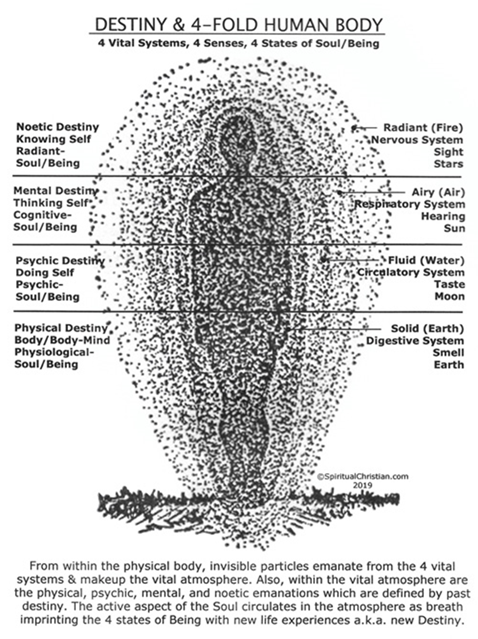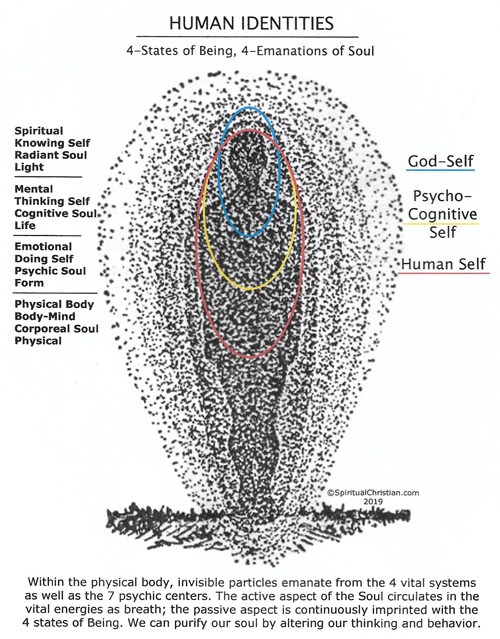BEING AND THE SOUL
The term “being” is frequently used in spiritual writings along with the terms “soul” and “spirit.” However, exactly how are these distinguished, one from another? Oftentimes, these terms are used interchangeably or in conjunction with each other as if they are representative of the same state, substance, condition, or person. For the individual who studies the mysteries of life and seeks the truth, having a distinct and precise definition of being, spirit, and soul means the difference between a general understanding and a lucid insight.
Much has been written about the being that we are as well as about the soul and spirit we possess, but this paper will offer a new and unique insight into the relationship between being and the soul, and explain how this relationship has everything to do with the regeneration of the soul. The first order of business is to distinguish between these terms. Most of the content on this website explains that we humans are a triune spirit of intelligence integrated into a 4-fold physical body comprised of elemental matter, and the spirit and body are connected through our breathing (see diagram at bottom).
The breath of a person is unique to that person and is ever-present throughout life. The breath of a person has “a formless form” that is beyond space/time and is unique to the individual; this breath-form is active as breathing and passive as the soul of the person. The function of the soul is to record the life experiences in every detail which it does as we imprint the soul with our thoughts, words, and deeds every moment of our waking existence.
What is referred to as being is the composite, passive expression of these accumulated experiences which are gathered from the activity of spiritual intelligence in the psycho-corporeal body; it is these experiences which the soul records. In other words, it is spirit and breath which bring life to our body physically, emotionally, and mentally; the experiences of our life create our being on these levels and the soul records this activity. It could be said that being and soul are active and passive aspects of each other; two sides of the same coin.
One Soul experiencing four expressions of
consciousness produces four states of being.

“Being” is a complex and difficult term to make sense of because of how it is used to describe the multiple facets of our nature as well as our existence on various levels of life. We humans are referred to as: a human being, a physical being, an emotional being, a conscious being, an authentic being, an integrated being, and some people may even be called an angelic or evil being. Obviously, the term “being” gets attached to a variety of descriptive conditions and passive states we humans’ emanate in life, but there is a more important aspect to being than just our present state.
The majority of people, at least those who think in such terms, consider themselves as an individual being, a distinct and unique entity existing in this time-space universe. In this regard, being is something we are, that is, a substantive state or unique identity we possess rather than a temporary condition we experience. This is important to understand. Rather than a passing state, our internal being represents (to ourselves and to others) who we are at the time.
The phrase “who we are at the time” is the key to understanding being. We know our being changes over time as we go through different life experiences, but what is important to comprehend is that since being does change, this also implies that we can change being, that is, we can transform our being.
Although the term “being” is used to describe existence on multiple levels and is frequently identified with a variety of psychological states like emotions, authenticity, or even consciousness, these terms create more confusion than clarity. The purpose of this paper is to reveal a new and different understanding of being. Consequently, the question we should be asking in our attempt to understand being is not “what is the state of being”, but rather, “what is the nature of being.” It is in the nature of being that we can discover its true character.
The first quality to be acknowledged regarding the nature of being is the presence of conscious awareness or intelligence. It is the intelligence in being that allows for us to be cognizant when our being is changed or transformed by different states of consciousness, by different life experiences, or by different states of nature which we humans encounter. As a result, we are aware as our psycho-corporeal being is transformed throughout the various stages of life as we experience altered states of consciousness such as maturity or transmutations in our elemental body like puberty.
Our physical being is changed internally and externally through these transformations as well as being changed psychologically, but not spiritually. The human being is a very complex entity; we experience life as a physical, emotional, mental, and spiritual being. However, for purposes of clarity, it is more accurate to describe someone as a spiritual self rather than a spiritual being. This may seem like splitting hairs, but it is not. It has been established in the preceding paragraphs that our being is changed by consciousness, life experiences, and nature, and that we can, if we know how, transform our being.
The significance of making this point is that we can transform our physical, emotional, and mental being, but we are unable to change or transform our spiritual being because it is already perfect. It could be said that our spiritual Self is comprised of God’s Being. So technically speaking, we are not a spiritual being but a spiritual Self because we cannot change or transform Spirit. This leads us to the mystical understanding regarding the Way of Life Jesus Christ revealed to humanity – that is, individuals who are inspired by the possibilities of spiritualizing human nature can transform their physical, emotional, and mental being into Spirit, just as Jesus Christ did.

An examination of the triune spiritual Self reveals that each of us is a knowing, thinking, and experiencing or doing individual who has the capacity to create. Only the doing self is fully integrated into the human body; what we perceive as our thinking and knowing self is connected to and functions in our consciousness, but at present, does not fully reside in the body. The qualities and attributes of our spiritual nature do not change because they are God-given and eternal; they are not in space/time reality.
The knower has the attributes of Self-knowledge and Self-identity (not ego/persona identity) which do not have degrees of more or less. In other words, when something is known, it is known; knowledge (noetic reality) and identity are known by the higher Self. The thinker has attributes of rightness and reason – rightness is our conscience and conscience does not change; it is not influenced or altered by culture, relativism, logic, or rationale, but it can be denied and ignored at great peril.
Reason is the knowledge of the Spirit; it is guided by the Spirit and its conclusions end in knowing; when a person is not skilled in the use of the reasoning mind, he or she reverts back to using the inferior rational ego-mind. The reasoning and noetic mind are a part of the spiritual Self, whereas the ego-mind is aligned with the psychology of the ego/persona, the body/body-mind, and the world.
Of our triune spiritual nature (intelligent-light), the doing self is integrated into our physical being and is experienced as the “body-mind.” This is how we are conscious of our physical body because it is infused with intelligence. The attributes of the doing self are feeling and desire which infiltrate the body and senses and use these to connect with the physical, sensual space/time reality we call the world.
Our personal experience with feeling/desire and mind in the physical body and senses is the grand mystery of life and the mystery of being. A human slowly and gradually awakens to the body and senses as a child, and gradually awakens to their personal identity during puberty.
As a result of this incremental awakening and the substantial and enticing activities of the world, the first mystery of life is that most people do not realize they are a spiritual self in a physical body. People think they are simply a body, mind, and ego in the material world; they identify with the elemental body. Thus, they devote their lives to satisfying the desires of the body while being lost in the delusion of their ego/personality. The illusion of this world is strong and thorough, and it is extremely difficult to awaken from its “glamour.”
As an individual being in a physical body, we are subject to powers, forces, and energies from which we are unable to escape. As an example, we must take in air, water, and food in order to sustain and maintain the health of our physical form. This miraculous form comes into this world automatically programmed with instincts for self-preservation.
For instance, drop a newborn into a body of water and it will immediately shut down its breathing; that is, it instinctually knows it cannot breathe water. A physical body, including animals, instinctually knows to be wary of heights; the body also has reflexes which pull it back from a perceived danger before the mind is aware of what is happening.
As humans in an elemental body, we also experience a variety of physical impulses, sexual desires, stress, anxiety, fear, loneliness, hunger, strength and weakness, biological processes, environmental pollution, physical injury, and pain. All of these experiences represent what it is like to be and to live life in a physical body which is driven by feeling and desire, sentiments, psychological perceptions, and mental perspectives; this is the ever-changing nature of being in a psycho-corporeal body.
The components of our emotional and mental (the cognitive, rational) being are distinctly different from our physical being; nevertheless, they blend, interact, and influence one another. When added to the ego/persona these form our “worldly self.” It is in the worldly self that being resides and it is this part of the human that can be transformed. The psychological nature is the realm of sentiment, happiness, sadness, euphoria, grief, anxiety, insecurity, loneliness, anger, apathy, jealousy, hate, and the like.
These emotions arise spontaneously and will create a corresponding psychological response in the intellect which may manifest verbally as well as create a physiological reaction which is experienced in the solar plexus as a “knot in the gut,” elation, or nervousness depending on what emotions arise. Likewise, our mental, cognitive, rational nature is comprised of a variety of concepts, perceptions, and misperceptions regarding the world, one’s self-image through the ego/persona, judgments regarding people, memory, and perspectives about life.
All of these physical, emotional, and mental attributes comprise the human being. Add the spiritual nature to the purified and transformed human being and we have the divine-human which Jesus Christ manifested in its fullness. To be clear, Jesus Christ is the Divine-human and the best we can be is a human-divine being. Nevertheless, Jesus clearly stated that the things which He did we can do also if we follow the Way of Life. The Way of Life leads us to the way of being divine.
It is the beingness of the human which can be transformed and the transformation and purification of our psychological being frees the soul from all darkness thus allowing for the soul to be regenerated; regeneration or resurrection of the soul is the purpose of salvation. Religious institutions teach that acceptance of Jesus Christ is all one needs for salvation and this is true if you are satisfied with a “general admissions” ticket into the Kingdom of Heaven; this is the “milk” of the truth.
For those who want the “meat,” the life of Jesus Christ represents is a long and arduous process which only starts with the acceptance of Jesus Christ, the acknowledgement and forgiveness of sins, and the receiving of the Holy Spirit through baptism. The advance work begins by “dying to the old self” through the complete transformation and purification of the physical, emotional, and mental being and embracing a new life as exemplified by Jesus Christ.
In addition to this, for those who wish to drink deeply of the living waters, there is the transformation and regeneration of our innermost being and soul through Stage 3 meditation. This is a very specific meditation which works with vital life, vital light, breath, and Spirit. To begin, see the Meditation section; the meditation overview explains the overall process.

SWEET ELEVATION
It makes me sad to think a great mountain will die,
That the stars will someday disappear from the sky.
Yet, when I witness the holiest gift of creation,
My heart warms with the anticipation of elevation.
For though I too am destined for ashes and dust,
When I reach for the light with the simplest trust,
The true omnipotence of a higher power,
Draws from my heart a sacred flower,
Which opens in faith to the sun in the sky,
Even as its sweet sorrow brings a tear to my eye.
Then, as I marvel at the holiness of all of creation,
Inhaling the pure fragrance of sweet elevation,
Like the mountain, being ground, down to dust,
I'm born again by the light of simple trust.
SpiritualChristian.com

*
* *

